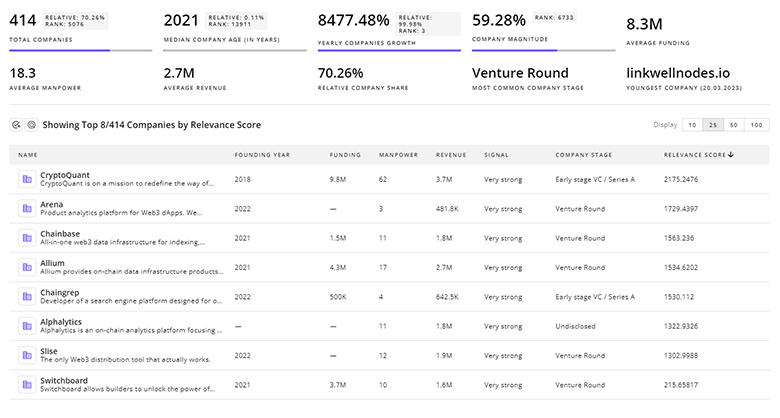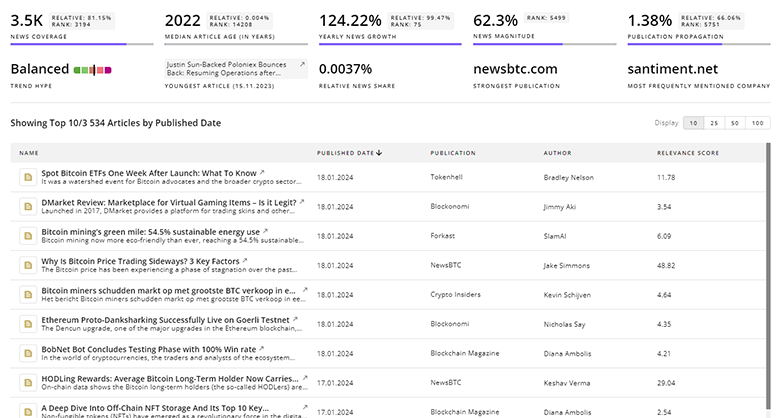
Edge Software Report
: Analysis on the Market, Trends, and TechnologiesThe edge software market is already material: it reached approximately $1.14 billion in 2023 and the internal data projects a 30.2% CAGR for the segment, signaling a rapid expansion of on-device and distributed software architectures over the next decade Edge AI Software | A $8.91B Market by 2030.
This article was last updated 7 days ago. If you find any info is missing, let us know!
Topic Dominance Index of Edge Software
The Dominance Index of Edge Software looks at the evolution of the sector through a combination of multiple data sources. We analyze the distribution of news articles that mention Edge Software, the timeline of newly founded companies working in this sector, and the share of voice within the global search data
Key Activities and Applications
- Real-time analytics for Industrial IoT: local preprocessing and inference to support predictive maintenance and closed-loop control for factories and field assets Edge AI Software Market Report.
- Edge orchestration and device management: remote provisioning, software rollout, health monitoring, and secure update mechanisms for fleets of heterogeneous devices
- Low-latency inference for autonomous and semi-autonomous systems: vision, sensor fusion, and decision engines executing on vehicle, drone, and robotics platforms to avoid round-trip delays Edge AI Software Market Forecast.
- Video and sensor analytics at the network edge: on-site object detection, aggregation, and privacy-preserving transformation to cut bandwidth and compliance exposure Edge Computing Market Report.
- Low-code/no-code edge application platforms and developer toolchains that reduce time to market for industrial and enterprise deployments Open, Automated, Anywhere: Red Hat's Edge Strategy.
Emergent Trends and Core Insights
- Platform consolidation with an ecosystem tilt: a few platform plays capture integration, security, and orchestration value while smaller vendors win by offering highly specific functions that integrate into those platforms.
- Edge AI adoption and model efficiency techniques: model compression, quantization, and TinyML approaches let larger AI capabilities run within tight CPU, memory, and power budgets
- Container and orchestration adaptation for distributed sites: Kubernetes variants and specialized runtimes address intermittent connectivity, small footprint nodes, and policy-driven rollouts KubeEdge.
- Security and compliance as a first-order requirement: encrypted gateways, device attestation, and standardized update paths become purchase drivers for enterprise buyers
- Developer productivity and integration toolchains: low-code builders, cross-compile toolchains and automated MLOps that port models to accelerators compress development cycles and reduce deployment risk
Technologies and Methodologies
- Containerization and edge orchestration: lightweight Kubernetes distributions and edge-aware orchestration patterns that handle offline operation and staged rollouts
- On-device ML frameworks and model optimization: TensorFlow Lite, ONNX Runtime and toolchains for pruning, quantization, and compiler-level acceleration to meet device constraints
- Secure data gateways and cryptographic pipelines: encrypted ingestion, policy enforcement, and data minimization to meet regulatory needs at the collection point
- Microservices and event-driven edge architectures: small, independently deployable services with publish/subscribe telemetry to scale across thousands of nodes Edge Total Intelligence.
- Low-code/no-code and automated toolchains for embedded deployment: pipelines that automate model optimization, cross-compilation and packaging for specific SoCs and RTOS targets
Edge Software Funding
A total of 258 Edge Software companies have received funding.
Overall, Edge Software companies have raised $5.1B.
Companies within the Edge Software domain have secured capital from 802 funding rounds.
The chart shows the funding trendline of Edge Software companies over the last 5 years
Edge Software Companies
ZEDEDA — ZEDEDA provides a cloud-native edge management and orchestration platform built around an open, lightweight edge OS to simplify fleet management, security, and remote updates; the company highlights thousands of nodes under management and an app marketplace that supports heterogeneous hardware and software stacks ZEDEDA sells into industrial and enterprise deployments that require secure lifecycle management and integrates open components to lower lock-in risk The vendor positions its offering as an enterprise bridge between cloud operations and distributed edge fleets, emphasizing policy driven updates and observability.
Intelligent Edge Systems — This Bengaluru R&D firm builds Edge AI toolchains and an automated pipeline that accelerates embedded application development, including model optimization, porting to accelerators, and generation of deployment artifacts; the company focuses on reducing time to market for embedded AI products Intelligent Edge Systems. Their multi-agent generative workflow automates code generation and debugging tasks for frameworks like GStreamer and ROS2, which lowers engineering friction for complex edge stacks Intelligent Edge Systems. The offering targets OEMs and system integrators that need repeatable, verified deployments across SoCs and FPGA targets Intelligent Edge Systems.
Edgee — Edgee positions itself as a full-stack edge platform that lets developers deploy WebAssembly and other components close to users via a global points-of-presence network; the company advertises >100 POPs and a high global capacity to minimize latency for web workloads Edgee focuses on cross-platform developer experience for multiple languages and cloud hosts, and it targets web and application use cases that benefit from relocating compute to the network edge Edgee. The product emphasis lies on simple developer tooling plus infrastructure presence rather than deep industrial integrations Edgee.
AGILEO Automation — Agileo targets OEMs and high-precision industrial equipment with control and connectivity software, including libraries for industry standards (SECS/GEM, GEM300) and MES integration to connect production tools to factory IT Agileo Automation. The company packages device control frameworks, connectivity middleware and simulation tools to accelerate qualification and integration of equipment in semiconductor, PV and advanced manufacturing lines Agileo Automation. That industry focus makes Agileo attractive for manufacturers that need certified, standards-compliant edge control stacks Agileo Automation.
Uncover actionable market insights on 5.0K companies driving Edge Software with TrendFeedr's Companies tool.

5.0K Edge Software Companies
Discover Edge Software Companies, their Funding, Manpower, Revenues, Stages, and much more
Edge Software Investors
Get ahead with your investment strategy with insights into 814 Edge Software investors. TrendFeedr’s investors tool is your go-to source for comprehensive analysis of investment activities and financial trends. The tool is tailored for navigating the investment world, offering insights for successful market positioning and partnerships within Edge Software.

814 Edge Software Investors
Discover Edge Software Investors, Funding Rounds, Invested Amounts, and Funding Growth
Edge Software News
TrendFeedr’s News feature offers access to 1.9K news articles on Edge Software. The tool provides up-to-date news on trends, technologies, and companies, enabling effective trend and sentiment tracking.

1.9K Edge Software News Articles
Discover Latest Edge Software Articles, News Magnitude, Publication Propagation, Yearly Growth, and Strongest Publications
Executive Summary
The evidence points to a fast-growing edge software market where scale and integration matter as much as functional depth. Buyers and investors should separate three value pools: orchestration and lifecycle services, domain-specific critical applications, and secure data plumbing. Firms that deliver lifecycle automation, clear security guarantees, and toolchains that compress engineering effort will extract the highest margins. At the same time, software vendors that narrowly solve essential problems for industrial and regulated verticals can sustain defensible positions by offering integration pathways into dominant platforms. Strategic choices should align product scope to one of these pools rather than attempt to compete across all three simultaneously.
Have expertise in trends or technology? Your input can enrich our content — consider collaborating with us!











